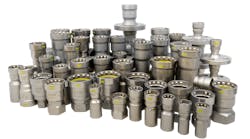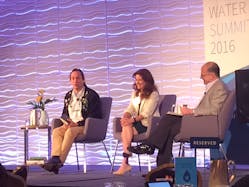MILWAUKEE — Last month water professionals from around the U.S. and world visited Milwaukee to attend The Water Council’s 9th annual Water Summit, focusing on how to establish water resilient cities.
During the two-day event attendees had the opportunity to network with one another and exchange ideas about global water issues and discuss innovative solutions. There were a variety of “conversations” in place of traditional panel discussions during the event, including topics about resilient infrastructure, innovative disruptors and resilient health (how water plays a key role in public health).
“The Water Summit represents a major gathering of the best thought-leaders in the water industry,” said Rich Meeusen, chairman, president & CEO of Badger Meter. “This event allows them to exchange views and ideas about cutting-edge technologies, innovative policies and current trends affecting this important industry. The Summit benefits a wide range of companies, from water utilities to large water users to water technology manufacturers.”
Of the few global summits devoted exclusively to fresh water and the growing issues of water availability and fresh water infrastructure, The Water Council in Milwaukee has been hosting the Water Summit since 2009. The Water Council is the brainchild of Meeusen and Paul Jones, retired executive chairman of A.O. Smith Corporation.
“We see this as an opportunity to learn about some of the latest technologies and best practices in water conservation,” said Chuck Wright, A. O. Smith’s director of corporate communications. “First and foremost, there are a number of new and emerging technologies that are going to have a big impact on this industry. The water and waste-water industries have been slow to adapt, for a number of reasons, but with major issues, such as drought and the water supply problems in Flint, Michigan, there is growing awareness of the importance of water and the fragile nature of the fresh water and waste water infrastructures. Second, these are global issues, and there are global solutions emerging to meet the needs.”
As the water supply and waste water infrastructure in this country continues to age and deteriorate, it’s going to impact more and more homeowners all over the country,—Chuck Wright
And why should plumbing contractors be concerned about water infrastructure issues?
“As the water supply and waste water infrastructure in this country continues to age and deteriorate, it’s going to impact more and more homeowners all over the country,” said Wright. “While most plumbing contractors will not be called upon to work on the large mains, these projects will create a ripple effect with the homeowners who get their water from the mains. In my town, for example, we had to close the local well due to high arsenic levels and connect to the municipal system. A number of plumbing contractors were brought in for the project which took the better part of the summer. Plumbing contractors should also be aware of the new technologies that will be available to homeowners including WiFi-enabled sensors and flow meters and new water purification products. As more consumers read about issues like Flint, they are going to start asking their plumbers for these types of products.”
A.O. Smith and Rexnord were platinum sponsors of the Water Summit.
It is important that everyone in the water industry is communicating with each other in order to continue to bring their customers the latest/greatest advancements in technologies, performance and water safety expertise,—Aline Daniel
“The Milwaukee Water Summit has become synonymous with all things water – as is Zurn Industries,” said Aline Daniel, director of sustainability at Zurn Industries LLC. “Zurn wanted to be at the epicenter of the Great Lakes Water efforts and as a result, our parent company [Rexnord] is building their headquarters there. “It is important that everyone in the water industry is communicating with each other in order to continue to bring their customers the latest/greatest advancements in technologies, performance and water safety expertise.”
Conversation on resilient revolution
All conversations during the Water Summit were led by Charles Fishman, author of “The Big Thirst” and Fast Company reporter. To discuss innovative disruptors in the industry were George Hawkins of the District of Columbia Water & Sewer Authority and Karen Guz of the San Antonio Water System.
This panel discussion started out with Fishman stating that the world of water is in need of transformation desperately — the infrastructure is falling to pieces and this system supplies an essential service.
“The pre-Flint story was the D.C. water system,” said Hawkins. “There was a four-year lead crisis in D.C. because we tried something new and it didn’t work. We went from chlorine to chloramine to reduce disinfectant byproducts. This change reduced the protective scaling in the lead service lines, and lead went into the water. In this industry you cannot try something and it fails because this is health related.”
The lead crisis in D.C. was in 2004, before Hawkins was hired to be the CEO and general manager of DC Water. Upon his arrival in 2009, his initiative was to transform DC Water into a customer-oriented enterprise. Plus, the core goal of DC Water is to improve aging infrastructure while complying with stringent regulatory requirements.
“People are always resistant to change,” said Hawkins. “For the first six months of my job I just listened to what people had to say… I heard the good stuff and then used it.”
Some of the positive statements he heard from within DC Water were “We are cleaning the water – taking out the pollutants” and “We are an environmental organization.”
Part of rebranding DC Water into a customer-oriented enterprise was to create a new logo, have a strong external affairs department, come up with programs for low-income residents, and be on the cutting-edge of technology — DC Water came up with a way to turn water waste into energy. The water district is using a Norwegian thermal hydrolysis system to convert sludge from treated sewage into electricity to power one-third of the plant’s power.
All in all, Hawkins’ philosophy is that external affairs are the underpinning of financial affairs, and it’s so important how water authorities interact with their customers.
“In D.C., it’s a city of extreme wealth and poverty and nothing in between,” said Hawkins. “I believe in charging a market cost for water except for the folks that cannot pay. Right now the “old” mindset about the water utility is leaving, and the role now is to help customers solve their water problems.”
Guz believes that at the heart of the infrastructure issue is socioeconomics.
“A lot of people live in poverty,” said Guz. “Increase of water rates for many people is a hardship. San Antonio has assistance programs to help people. For example, San Antonio has a toilet replacement program, Plumbers to People, which is one of San Antonio’s first programs.
According to its website, the program was implemented in 1994 to provide plumbing assistance to low-income residential customers seeking repairs to leaking plumbing fixtures in their homes.
Conversation on resilient economies
Panelists discussing Resilient Economies were Kevin Shafer of U.S. Water Alliance, Water Environment Reuse Foundation and Milwaukee Metropolitan Sewerage District; Patrick Schultz of Veolia; and Maureen Stapleton of San Diego County Water Authority.
The basis of this discussion was the cost of water being delivered to homes. How do you get money for infrastructure when people don’t want to pay?
“Water has been the forgotten resource for some time,” said Shafer. “Water is now becoming an issue — there’s been a tipping point with droughts, water quality, etc. Water has been forgotten for so long, but has come back to the forefront.”
According to Schultz, the industry needs to think about getting the most value out of the money currently available.
“We need to think of the most efficient operation,” said Schultz. “There is money locked up in inefficiencies that could be used elsewhere.”
According to Stapleton, transparency is key and leaders are needed that will dive deep into efficiencies.
“We need leaders that are transparent and can lean into the discomfort of going out on a limb to make things more efficient,” explained Stapleton. “Water quality is from a public agency standpoint. Citizens have put their trust in us.”
Stapleton added that communication with the public needs to be ongoing, but it does cost money to communicate.
“We started from the ground up — the water authority started with presentations,” explained Stapleton. “You cannot expect mass mailings to get the word out about water — mass mailings see the recycling bins. The water authority has to be out there at different levels — we are in the schools (elementary, high school and college), we have a robust website and social media too. We also decided to focus on talking with different groups, such as homeowners, landscape architects, etc., to educate them about water and its cost.”
Conversation on resilient health
It’s no surprise that the Flint, Mich., water crisis was on the minds of everyone attending the Water Summit. During the Resilient Health conversation, Fishman noted that lead contamination in Flint is making people suspicious of lead being in their water, and there is a connection between the pipes in the system and public health. Panel members included Barry Liner, director of the Water, Science & Engineering Center from the Water Environment Federation, Magda Peck of MP3 Health Group and Joel Beauvais of the Environmental Protection Agency.
“At this time, there are six to 10 million lead service lines serving the U.S.,” said Fishman. “We have a lot of challenges to face that the public doesn’t know about.”
According to Peck, there is disconnect between the water system and the health system, and the lessons learned from the past tell us public health is defined by:
- Prevention — We need to think before things happen, so when things do happen it’s not that bad. For example, if there is lead how do we filter it?
- Community — Public health is not about the individual, it’s about the community. The health industry needs to look at patterns in the population and share this with the water industry.
Plus, public health is not a science in itself – public health and water leverage one another.
According to Beauvais, the infrastructure is a huge problem, but the industry needs to look at other ways to attack the problem, such as point of use products, training, etc.
“The small water systems need to meet the same theory as the large systems, yet they are at a disadvantage,” said Beauvais. “There are 10 water systems per county in the U.S., and the quality is supposed to be across the board.”
Some states through policy and financial incentives are making bold moves to consolidate water systems. For example, Kentucky had 1,800 water systems and now they are at 360 systems via a state policy to consolidate.
Word from sponsors
Many companies sponsored the Water Summit, such as A.O. Smith, Rexnord, Pentair, Badger Meter and Nelson Schmidt.
“Since its inception, the annual Water Summit has epitomized why the worldwide water industry's social and economic impact continues to grow exponentially ... inclusion of a wide range of organizations focused on a common vision,” said Christopher Vitrano, chief marketing officer of Nelson Schmidt Inc. “As a result, when it comes to addressing global water issues and opportunities — public and private enterprises, academia, government and NGO entities come together to advance the quality of life on a local, regional and international scale. That's very unique in today's social and political environment ... very cool to contribute to ... and something Nelson Schmidt is very proud to be a part of.”
“It’s an opportunity to come together and not only discuss the challenges that face our industry today, but also the opportunities,” said Kathleen Fugler, communications manager of Pentair Water Purification. “It gives companies new and old, large and small, the chance to share ideas about how we change the national conversation about water.”



